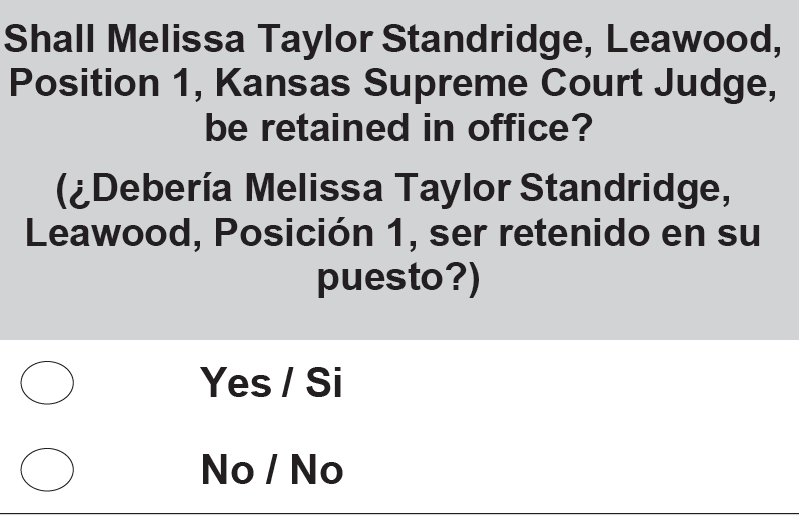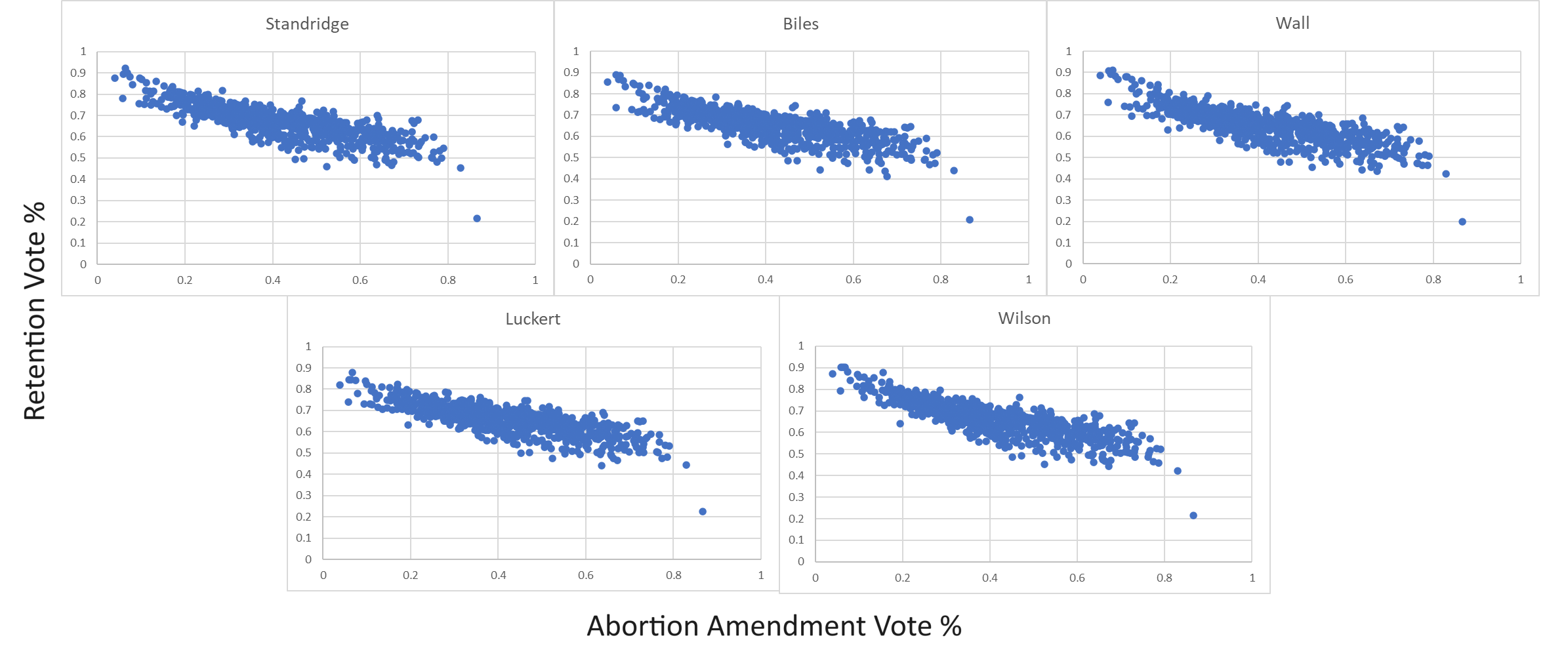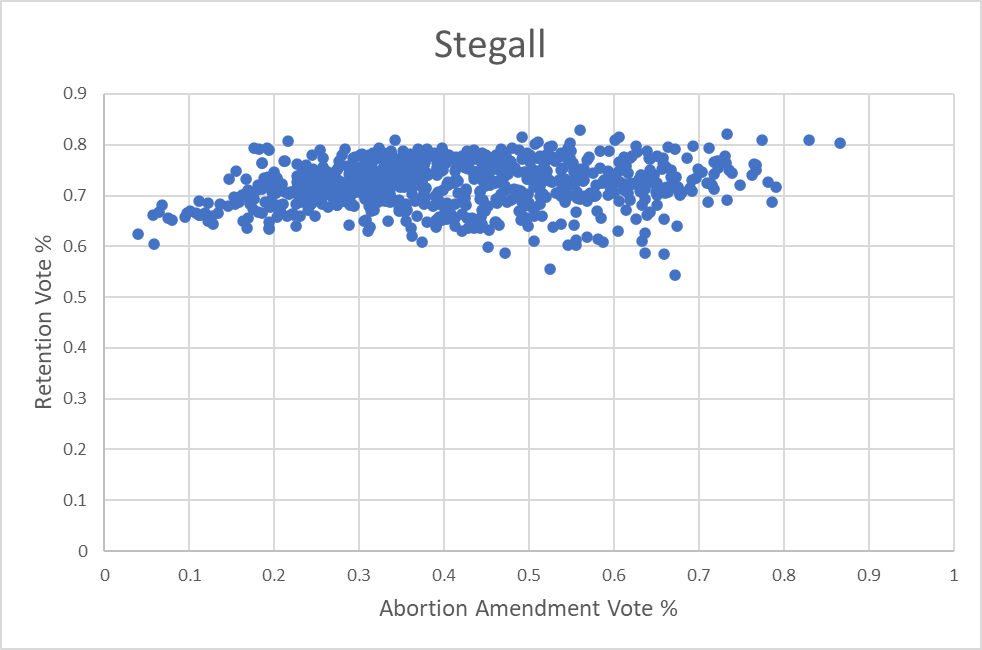Abortion and Supreme Court Retention in 2022
Brian Amos
Assistant Professor, Wichita State University
February 21, 2024
The failure of the “Value Them Both” amendment in the August 2022 election was a
major victory for supporters of abortion rights in Kansas.
While passage would not have directly restricted it in the state,
it would have had the effect of overturning a 2019 Kansas Supreme Court decision
where six of the seven justices affirmed state constitutional protections on abortion access.
Given the majority ideology of the legislature and the U.S. Supreme Court’s
lifting of federal constitutional protections on abortion in their
Dobbs v. Jackson Women’s Health Organization ruling, however,
it seemed a given that passage of Value Them Both would lead to some degree
of abortion restriction.
 An example of retention on the ballot. This comes from Ford County,
which has Voting Rights Act requirements for bilingual voting materials.
An example of retention on the ballot. This comes from Ford County,
which has Voting Rights Act requirements for bilingual voting materials.
An alternative to overriding the court would be replacing the court,
and by coincidence, six of the state supreme court justices were up for retention
in the November 2022 election: five who voted to protect abortion rights,
and the one dissenter, Caleb Stegall.
Looking across the nation, “no” votes on retention are incredibly rare,
with a handful of high-profile examples involving justices who opposed the death penalty,
and in 2010, three Iowa justices who ruled in favor of gay marriage.
In Kansas, attempts were made against perceived-liberal justices in 2014 and 2016,
and they were very nearly successful: the strongest performance was only 56% in
favor of retention, and Justice Lee Johnson survived with just 52.6% of the vote.
So, the 2022 general could have developed into a rematch on the issue of abortion.
Unlike in 2014 and 2016, though, there was not a well-organized campaign
against the more liberal justices. Given the surprisingly large defeat of the
Value Them Both amendment in August, this was probably a strategic choice:
re-mobilizing pro-abortion voters could have had spillover effects into
the close elections projected in the gubernatorial and attorney general races.
Democrat Laura Kelly ended up winning re-election for governor regardless,
but Republican Kris Kobach narrowly won victory for the latter office,
so the choice may have been a good one.
Even with no large-scale campaign against the liberal justices, anti-abortion
groups like Kansans for Life still issued voter guides for the election recommending
“no” votes for the five liberal justices and a “yes” vote for Stegall.
This leads to an empirical question: do we see a relationship between an area’s
vote on the Value Them Both amendment and their votes for retention?
To answer the question, I reaggregated the results from both elections to the
Census tract level, which is a unit of geography defined by the Census Bureau
with a usual population around 1000 to 5000 people; Kansas is divided into a
little over 800 tracts. I’ve plotted out the patterns for the five more liberal
justices below, with each dot representing a Census tract,
the horizontal axis measuring the Value Them Both amendment vote,
and the vertical axis measuring the retention vote for that justice.

There’s a clear and consistent pattern in the expected direction.
The more voters who supported amending the state constitution to remove abortion protections,
the more voters who voted against retaining those justices.
The correlations are high, with an average R2 of around 0.65.
The slope of the prediction lines are roughly around -0.4: each additional 10 points
in favor of the amendment predicts an additional 4 points against retention.
So, the relationship isn’t perfect, but given the relatively weak campaigning
against the justices, this might be surprisingly strong,
especially when retention elections usually take a backseat to all of the
statewide executive races that they share a ballot with.
As an aside, there is an outlier tract that is immediately noticeable on all five charts.
In the bottom right, there is the tract which had the highest support in the
state for the August amendment, and by far the lowest level of support for the
five liberal justices. This is the tract that contains St Marys,
a city with a strong presence of a distinct strain of conservative Catholicism;
The Atlantic
wrote an article about the area a few years back.
That leaves the sixth judge up for retention, Caleb Stegall, whom Kansans for Life
did endorse. Do we see the opposite pattern when comparing his vote to the August abortion
amendment vote?

The answer seems to be no. If we drop in a regression line,
there is a slightly positive trend, driven in part due to the most anti-amendment
tracts having lower levels of support for Stegall and the most pro-amendment tracts
having relatively high levels of support, but it is a 1-to-19 slope instead of the
4-to-10 slope from the others. The R2 is only 0.033 – knowing a tract’s
support of the abortion amendment just barely improves your prediction on
Justice Stegall’s retention versus guessing the mean.
What happened here? Unfortunately, I don’t have individual-level data to
test out any theories, but I can speculate. First, protecting abortion was an
issue in the November election, but it wasn’t nearly as salient as it was in
the August election. Dr. Alex Middlewood and I wrote a paper looking at who was
activated by the abortion amendment in the primary and who stayed on to vote
again in the general, and about half of the newly registered voters for the
former didn’t bother turning out in the latter. Douglas County, home of the
University of Kansas, actually had lower turnout in the general than the primary,
which happens just about never.
Second, even if voters did recognize the importance of the retention elections
for the continued protection of abortion rights, the status quo was good enough.
The easy shorthand to remember was yes votes across the board – this would give
support to Justice Stegall, but he was one dissenter among seven, and was unlikely
to lose regardless.
This does raise the question of what would have happened if abortion protection
had been made more salient, and the chart for Justice Stegall was made to look the
opposite of the ones for the five other judges. Democrats in Kansas would certainly
have liked to have kept Kris Kobach out of office, so this may have been a missed
opportunity to tap an electorate that was mobilized in August.
|

